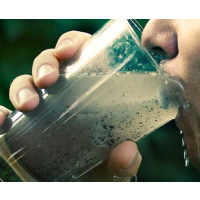Spotty Data Leads EPA to Declare No “Systemic” Fracking Threat to Drinking Water

A study by AllGov California has found that hydraulic fracturing (fracking) methods used by the oil and gas industry pollutes drinking water but, like the first major study (pdf) of the issue released Thursday by the U.S. Environmental Protection Agency (EPA), insufficient data makes reliable conclusions difficult to extract.
The AllGov study consisted of Googling the vast storehouse of horror stories on the Internet about poisoned aquifers, dangerous injection wells, lousy oversight by government and thoughtless behavior by greedheads. The long-awaited EPA assessment, which is still in draft form, relied on 950 sources of information from published papers, technical reports and data from interest groups rather than a comprehensive survey of fracking operations.
Such a survey would be impossible, because fracking operations aren't monitored closely anywhere in the country. California is only now slowly beginning to canvass fracking operations and regulate some of the more egregious behavior.
The report is remarkable for what it does not do: “This report is not a human health risk assessment. It does not identify populations that are exposed to chemicals, estimate the extent of exposure, or estimate the incidence of human health impacts.”
It’s sole focus is on determining what impact fracking is having on drinking water and after looking over the available literature concluded, “We did not find evidence that these mechanisms have led to widespread, systemic impacts on drinking water resources in the United States.” The number of identified cases of harm to drinking water from fracking “was small compared to the number of hydraulically fractured wells.”
The oil and gas industry immediately embraced the findings as a clean bill of health and cited statements from the report such as, “This finding could reflect a rarity of effects on drinking water resources.”
“After more than five years and millions of dollars, the evidence gathered by EPA confirms what the agency has already acknowledged and what the oil and gas industry has known,” Erik Milito, upstream group director for the American Petroleum Institute, told the National Journal. “Hydraulic fracturing is being done safely under the strong environmental stewardship of state regulators and industry best practices.”
But the draft report, ordered by Congress in 2010, also touches on other possible reasons why very few problems, relatively speaking, were found:
“These factors include: insufficient pre- and post-fracturing data on the quality of drinking water resources; the paucity of long-term systematic studies; the presence of other sources of contamination precluding a definitive link between hydraulic fracturing activities and impact; and the inaccessibility of some information on hydraulic fracturing activities and potential impacts.”
A not-insignificant amount of the data is self-reported by the oil and gas industry.
Well-stimulation techniques have been around for decades, but new technological refinements and marketplace changes helped launch an explosion in U.S. oil output in recent years. Drillers are reanimating old, abandoned wells and tapping sites once thought inaccessible. Fracking in the 21st century involves toxic chemicals, high volumes of pressurized water, sand and hydrochloric or hydrofluoric acid.
Critics say fracking has been linked to groundwater contamination, air pollution, releases of methane gas, micro-earthquakes and sink holes. But the EPA report dealt with just fracking and its effects on drinking water.
Although the EPA found no “systemic” problems, it did report a range of anecdotal issues:
“Spills of hydraulic fracturing fluid and produced water in certain cases have reached drinking water resources, both surface and ground water. Discharge of treated hydraulic fracturing wastewater has increased contaminant concentrations in receiving surface waters. Below ground movement of fluids, including gas, most likely via the production well, have contaminated drinking water resources. In some cases, hydraulic fracturing fluids have also been directly injected into drinking water resources, as defined in this assessment, to produce oil or gas that co-exists in those formations.”
California has 50,000 injection wells, which get rid of the liquid detritus from oil drilling. Drilling produces eight times more waste water than extracted oil. But the state just recently completed surveying them and has identified at least 2,500 wells that are pumping wastewater into the ground near aquifers protected by the federal government. The state has already closed 23 of the most egregious wells.
The EPA report noted that it couldn’t do a great job of tracking harm done by injection wells, which handle 40% of drilling wastewater nationally, due to a lack of data.
–Ken Broder
To Learn More:
The EPA Just Released a Long-Awaited Study on Whether Fracking Causes Water Pollution (by Natasha Geiling, ThinkProgress)
EPA: Fracking Doesn't Pose “Widespread, Systemic” Danger to Drinking Water (by Tim McDonnell, Mother Jones)
EPA Gives Good News to the Gas Industry (by Jason Plautz, National Journal)
Fracking Poses Risks to Drinking Water, EPA Says, but Hasn't Caused “Systemic” Damage (by William Yardley, Los Angeles Times)
Aquifer-Polluting Oil Industry Injection Wells to be Closed, Maybe, Starting in Six Months (by Ken Broder, AllGov California)
Assessment of the Potential Impacts of Hydraulic Fracturing for Oil and Gas on Drinking Water Resources (U.S. Environmental Protection Agency)
- Top Stories
- Controversies
- Where is the Money Going?
- California and the Nation
- Appointments and Resignations
- Unusual News
- Latest News
- California Forbids U.S. Immigration Agents from Pretending to be Police
- California Lawmakers Urged to Strip “Self-Dealing” Tax Board of Its Duties
- Big Oil’s Grip on California
- Santa Cruz Police See Homeland Security Betrayal in Use of Gang Roundup as Cover for Immigration Raid
- Oil Companies Face Deadline to Stop Polluting California Groundwater





